Being one of the most beautiful and ecologically diverse states, Tennessee is also home to numerous birds, including hawks, who hang out in specific habitats and locations. All the terrain is often covered by several active and contingent birders who are constantly alert for the latest rarity.
All the hawks regularly sighted in Tennessee can also be spotted in many other states, but most hawks are easily found here since they breed and winter in significant numbers. To see the best places for birding in Tennessee, you would have to go on a long trip and drive a lot of miles.
The number of hawks within the state is certain to grow. Below are nine types of hawks that you can find in Tennessee. To see them, you’ll explore the marshes, prairies, cliffs, forests, rivers, and many other habitats.
1. Sharp-shinned Hawks
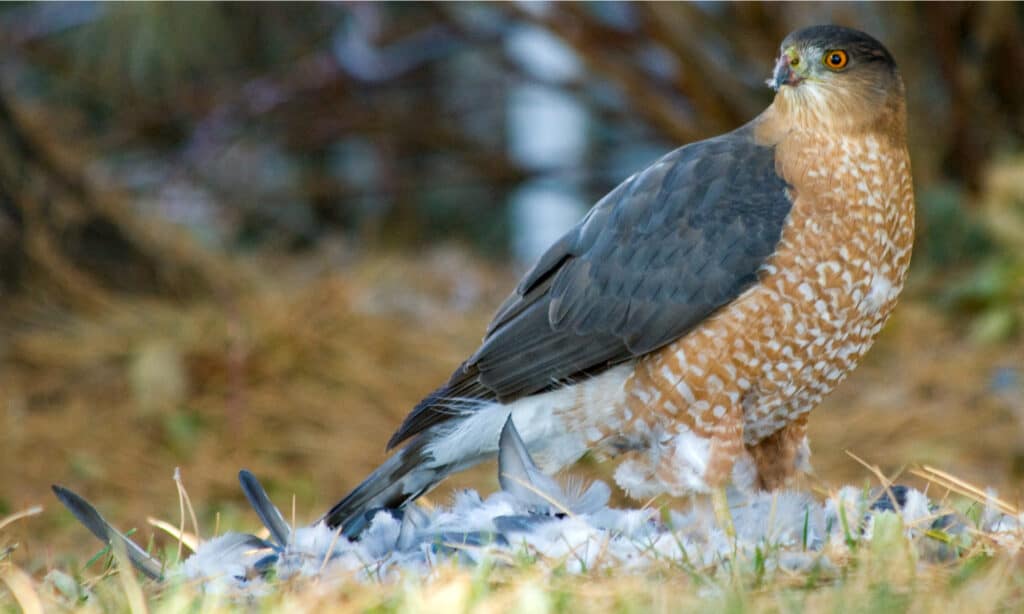
Sharp-shinned hawks live in dense forests and woodlands.
©Wyatt W/Shutterstock.com
| Sharp-shinned Hawks | |
|---|---|
| Scientific name | Accipiter striatus |
| Weight | 2.9-7.7 oz (82-219 g) |
| Height | 9.1-15 in (23-37 cm) |
| Wingspan | 17-27 in (42-68 cm) |
Sharp-shinned hawks are among the fastest hawks when hunting their prey. They live in dense forests and woodlands. Their diet consists of small mammals such as rodents, lizards, snakes, frogs, wood warblers, and many other small birds. They are widespread in Eastern Tennessee during the autumn migration.
Sharp-shinned hawks build their nests high in trees where the females lay 3–8 white or pale blue eggs and incubate them for about 30 days. Females brood on the young ones until they start to fledge, while the male provides food and protection.
These hawks nest in secretive parts of trees to avoid potential predators such as Cooper’s hawks and northern goshawks. They are also vulnerable to peregrine falcons and eagles, especially during migration.
2. Red-tailed Hawk
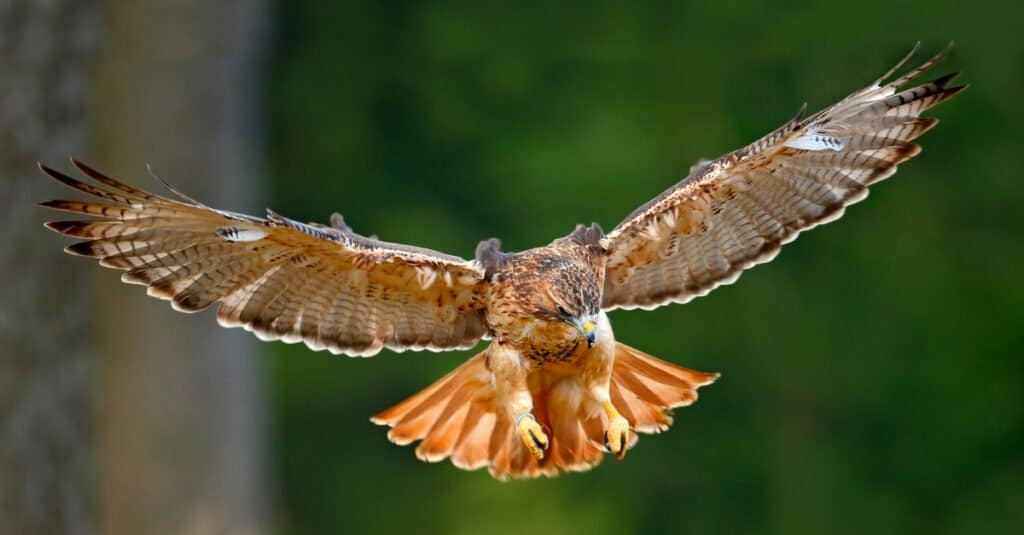
Red-tailed hawks build their nests in the crotches of tall trees.
©Ondrej Prosicky/Shutterstock.com
| Red-tailed Hawk | |
|---|---|
| Scientific name | Buteo jamaicensis |
| Weight | 1.5-3.5 lbs (680-1586 g) |
| Height | 18-26 in (45-65 cm) |
| Wingspan | 43-56 in (110-141 cm) |
Red-tailed hawks are very common in Tennessee and can be spotted in trees along roads and poles. They are the second-largest hawks in North America, with a distinctive red tail, just as the name suggests.
These hawks can adapt and hunt in any type of habitat. They feed on small mammals such as mice, marmots, fish, voles, rats, snakes, and small birds like pigeons. They are susceptible to attack by great-horned owls and bobcats.
Red-tailed hawks build their nests in the crotches of tall trees. Females lay between 4–6 white eggs and incubate them for about 35 days, while the males protect and provide food for them. After 6-7 weeks, the hatchlings can fledge but still stay close to their mothers for food and survival.
3. Northern Harrier

Northern harriers are well known for their long wings and tails, which are relative to their body size.
©Harry Collins Photography/Shutterstock.com
| Northern Harrier | |
|---|---|
| Scientific name | Circus hudsonius |
| Weight | 11-27 oz (300-750 g) |
| Height | 21-25 in (53-64 cm) |
| Wingspan | 41-46 in (103-117 cm) |
Northern harriers are well known for their long wings and tails, which are relative to their body size. They can be found in various habitats, including wetlands, grasslands, swampy areas, and farmlands. They are spotted mainly in May and during the winter season.
These raptors hunt for voles, ground squirrels, and cotton rats. They also hunt for smaller birds like bats and pigeons. Also, they have a good hearing ability, which facilitates their hunting process.
Northern harriers nest in tall vegetation or near low shrubs. Females lay between 4-5 dull white eggs and incubate them for about 28 days before hatching. Together with their nestlings, northern harriers are prone to attack by raccoons, dogs, skunks, foxes, and many other large birds of prey.
4. Cooper’s Hawk

Cooper’s hawks inhabit wooded habitats and deciduous forests.
©Richard G Smith/Shutterstock.com
| Cooper’s Hawk | |
|---|---|
| Scientific name | Accipiter cooperii |
| Weight | 7.8-14.5 oz (220-410 g) |
| Height | 14-20 in (35-50 cm) |
| Wingspan | 24-39 in (62-99 cm) |
Cooper’s hawks are among the fastest hawks in Tennessee. They inhabit wooded habitats and deciduous forests. They are famous for being fearless and aggressive raptors. Cooper’s hawks hunt other small birds like pigeons and doves. They also feed on rats, mice, voles, and snakes. They are also not afraid to catch small animals to supplement their diet.
Cooper’s hawks are known to be monogamous raptors. They build a nest high in leafy trees where the females lay between 3-4 whitish or pale blue eggs. Incubation lasts for 32–36 days before hatching. The young ones take 3-4 weeks to grow wings and can fledge at this age.
5. Red-shouldered Hawk
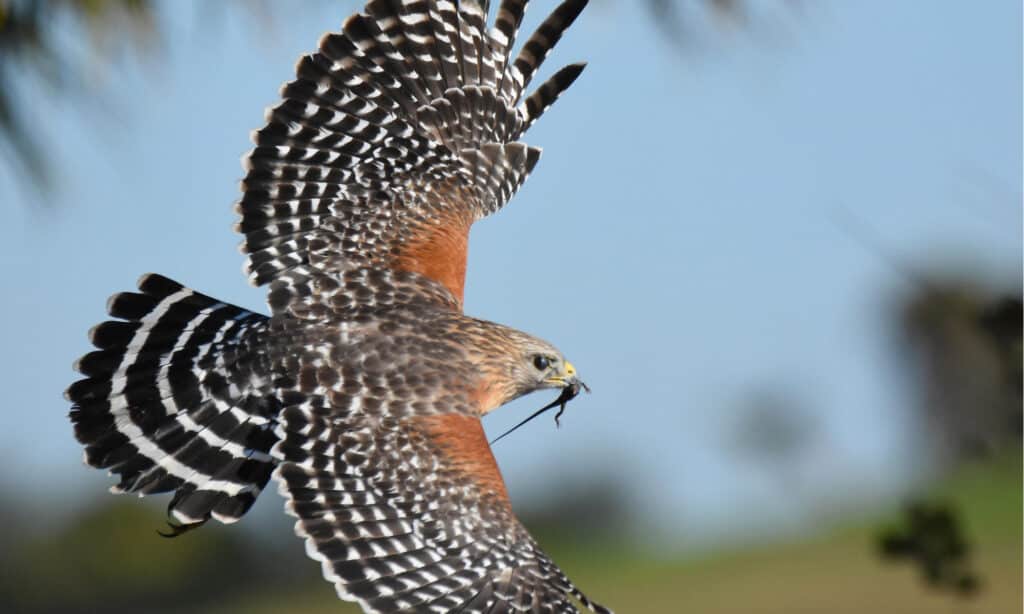
Red-shouldered hawks hunt for their prey while soaring over the woods.
©MTKhaled mahmud/Shutterstock.com
| Red-shouldered Hawk | |
|---|---|
| Scientific name | Buteo lineatus |
| Weight | 1-1.7 lbs (486-774 g) |
| Height | 15-24 in (38-61 cm) |
| Wingspan | 35-50 in (90-127 cm) |
Red-shouldered hawks live in wet deciduous swamps and open sub-canopy areas in Tennessee, which makes their hunting easier. They can also be found in suburban areas where trees surround houses. The best time to see them is during their migration season in autumn.
Red-shouldered hawks hunt for their prey while soaring over the woods or on treetops since they have excellent vision. Their diet mainly consists of mice, voles, moles, chipmunks, rabbits, tree squirrels, small snakes, birds, and insects.
These hawks breed in wooded and wet areas. The breeding pair build a nest where they lay three to four brown eggs and incubate them for 28-33 days. After hatching, the female broods the hatchlings for 40 days.
6. Rough-legged Hawk
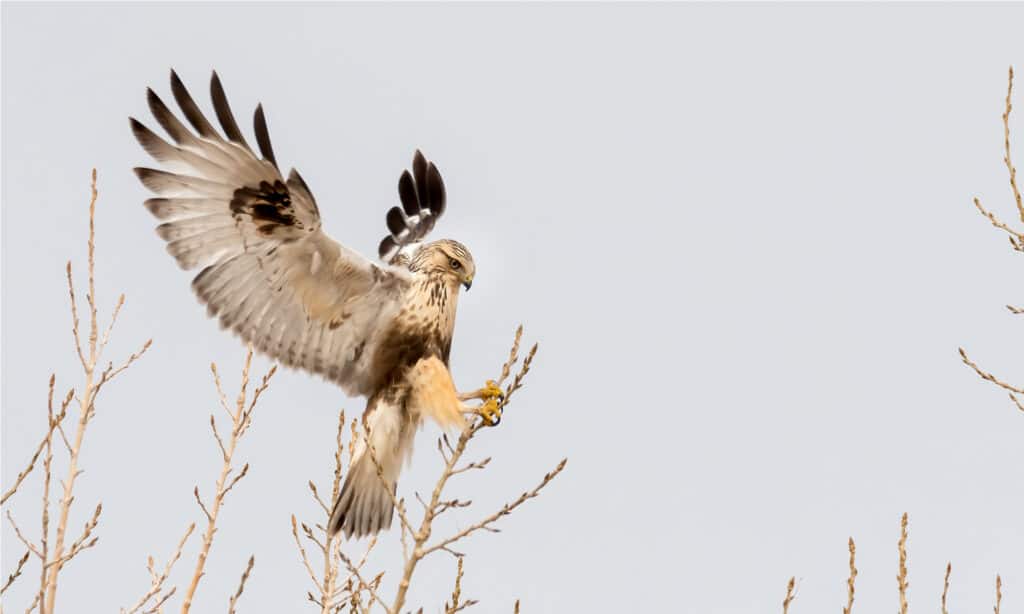
Rough-legged hawks attain sexual maturity at two years and are monogamous.
©Eivor Kuchta/Shutterstock.com
| Rough-legged Hawk | |
|---|---|
| Scientific name | Buteo lagopus |
| Weight | 1.32-3.66 lbs (599-1660 g) |
| Height | 18-24 in (46-60 cm) |
| Wingspan | 52-54 in (132-138 cm) |
Rough-legged hawks are Tennessee’s most easily identifiable raptors. They hover around open fields, looking for prey. They are also very territorial and aggressive towards intruders.
These raptors feed on small mammals such as voles, mice, moles, and lemmings. Small birds like snow buntings are the second favorite prey for rough-legged hawks. Large falcons and numerous falcons prey on rough-legged hawks.
Rough-legged hawks attain sexual maturity at two years and are monogamous. Nests are built during the breeding season, and the females lay between 3-5 eggs. The incubation period lasts about 31 days. The hatchlings take 4-6 weeks to fledge. They depend on their parents for survival, even after 2-4 weeks of fledging.
7. Broad-winged Hawk
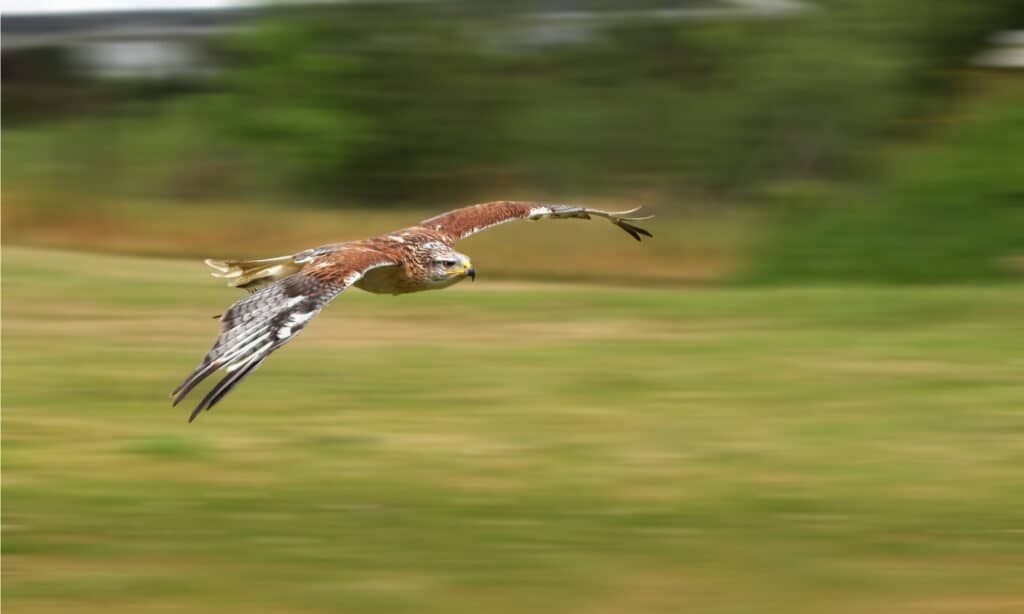
Broad-winged hawks mainly feed on mice, chipmunks, frogs, lizards, snakes, insects, crabs, etc.
©pr2is/Shutterstock.com
| Broad-winged Hawk | |
|---|---|
| Scientific name | Buteo platypterus |
| Weight | 9.3-19.8 oz (264-561 g) |
| Height | 13.4-17.3 in (34-44 cm) |
| Wingspan | 31.9-39.4 in (81-100 cm) |
Just like the name suggests, broad-winged hawks have broad wings which are pointed at the end. They also have short, dark brown bodies with white bellies. They inhabit forested areas near wetlands. They have been observed to migrate in eastern Tennessee near Chattanooga between mid-September and early October.
Broad-winged hawks mainly feed on mice, chipmunks, frogs, lizards, snakes, insects, crabs, and other small animals that they can easily skin. These hawks are prone to predation by the American black bear, porcupines, crows, and raccoons.
Broad-winged hawks build their nests on the lower parts of large trees, such as coniferous and deciduous. Females lay between 1 and 5 eggs and incubate them for 28-31 days.
8. Northern Goshawk

Northern goshawks are very territorial birds of prey that live in forested areas.
©Henk Bogaard/Shutterstock.com
| Northern Goshawk | |
|---|---|
| Scientific name | Accipiter gentilis |
| Weight | 1.4-4.8 lbs (635-2177 g) |
| Height | 18-27 in (46-69 cm) |
| Wingspan | 40-46 in (103-117 cm) |
Northern goshawks are very territorial birds of prey that live in forested areas where they can hunt for prey easily and nest in trees. They have short tails and long wings that help them maneuver around the forest in search of a meal.
They are mighty hunters with robust legs. Their prey consists of ground squirrels, mice, moles, rabbits, snakes, lizards, and small birds like pigeons and doves. Northern goshawks are vulnerable to predation by fishers, martens, great-horned owls, and red-tailed hawks.
9. Swainson’s Hawk
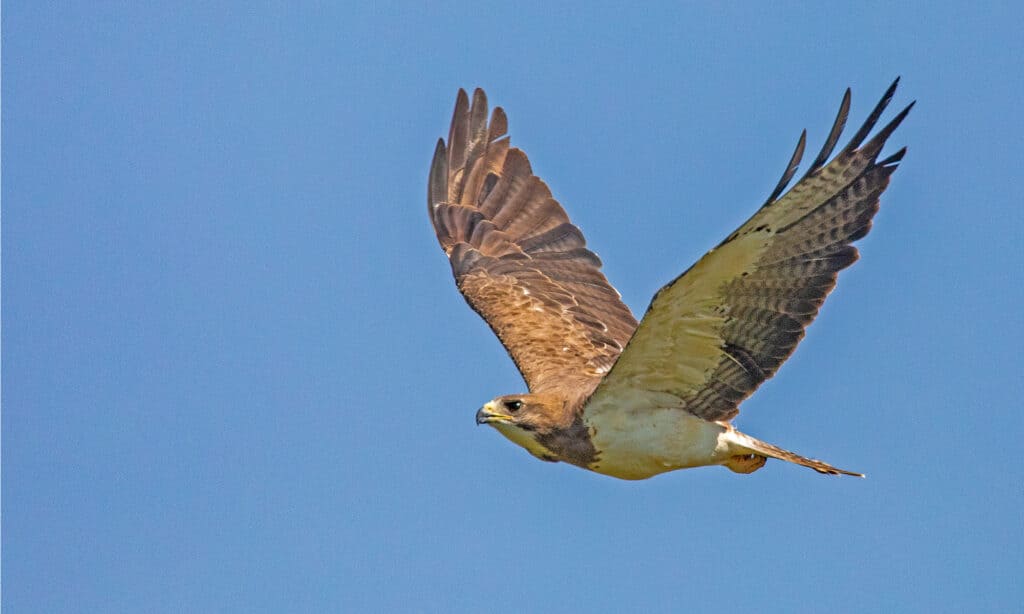
Swainson’s hawks are birds of prey named after a British naturalist, William Swainson.
©Lowell Monke/Shutterstock.com
| Swainson’s Hawk | |
|---|---|
| Scientific name | Buteo swainsoni |
| Weight | 1.1–3.7 lbs (499-1678 g) |
| Height | 17-22 in (43-56 cm) |
| Wingspan | 46-54 in (117–137 cm) |
Swainson’s hawks are birds of prey named after a British naturalist, William Swainson. They inhabit different habitats, such as prairies, grasslands, and even deserts. Many Swainson’s hawks hunt by perching on a tree, telephone pole, or other high places. They also soar through open fields in search of prey.
Their diet consists of young squirrels, cottontails, mice, rabbits, large insects, toads, young salamanders, and small or large injured birds. Swainson’s hawks are susceptible to predation by bobcats, coyotes, and golden eagles.
They build their nests on top of trees along a stream or on a solitary tree in a farm field. Females lay up to 4 eggs and incubate them for 34–35 days. The male provides food for the female during the incubation period.
The photo featured at the top of this post is © Harry Collins Photography/Shutterstock.com
Thank you for reading! Have some feedback for us? Contact the AZ Animals editorial team.






